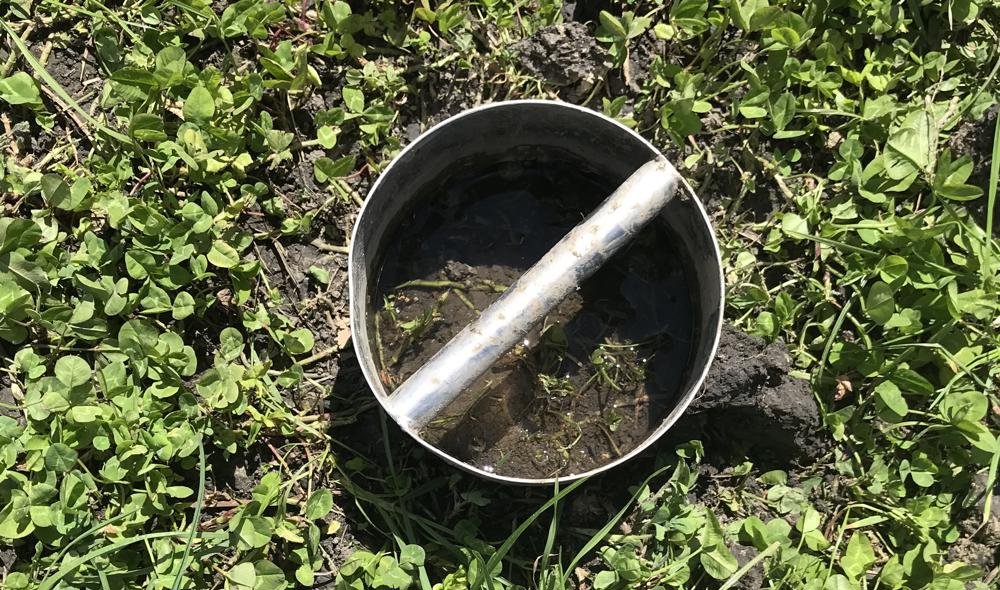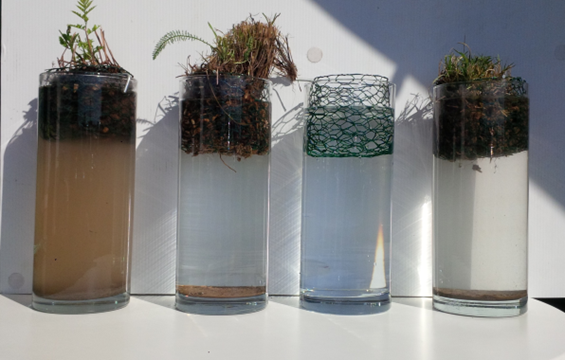How to assess soil health
Establishing a soil health baseline and monitoring programme is a powerful way to drive soil health improvements.
The tools below will get you familiar with your soil structure, biological activity and nutrient levels and help identify any low hanging fruit.
“What gets monitored gets managed!”
Inspecting soil health at a Quorum Sense field day (Photo Sam Lang)
Tools to assess soil health and identify limiting factors
“…if you looked at the soil tests, they were bloody awesome, like everything was perfect. You wouldn't have changed a thing really.
“But then if you got your spade out and dug a hole, you couldn't find any worms. The soil structure was no good and there was not a lot of clover.”
Ross Johnson - mixed arable & beef farmer, Wairarapa
Visual soil assessment (VSA)
Worm counts are a great indicator of soil health
The full VSA requires you to identify representative sample sites across your farm and follow a process of identifying and comparing various soil health indicators. Once familiar with the process it can be completed relatively quickly.
You can download VSA guides developed by Graham Shepherd for pasture and cropping here and for other land uses here.
A small start up called Vidacycle have developed a paid app called Soil Mentor that helps explain VSA monitoring processes, records the results, and presents the data in useful ways.
The FAR arable mini-VSA is a quicker and simpler process focusing on three key indicators for cropping soils. Instructions and scoring sheet can be downloaded on their website.
The simple ‘spade test’
A simple visual judgement of soil conditions by digging holes observing things like;
How easy/hard was it to get your spade in the soil?
How well aggregated is it?
Is there a difference in colour?
Are there more or less worms or insect pests?
Does it smell ‘earthy’ or sour/acidic?
Are your soils thatchy?
Forgot your spade? Don’t worry! You can observe a lot on top of the ground such as;
Is your animal dung, plant litter, or crop stubble breaking down quickly or slowly?
Is your pasture/crop growth even or patchy?
Penetrometer
Measures the amount of resistance/compaction vertically through the soil profile, and therefore indicates the depth and ease in which plants roots can grow.
South Otago dairy farmer Mark Anderson compares the compaction under bale grazing litter with the surrounding pasture
Refractometer / Brix testing
Measures the sugar content in a liquid, typically sap or juice from plants (brix). In pastures and crop leaves, brix helps indicate whether plants are efficiently converting sunlight into energy or not.
A refractometer for measuring brix
Achieving high brix (i.e. >12 with unrolled sample) is a common goal for regenerative farmers as it indicates plants have more energy for growth, feeding soil microbes via plant root exudates, and become more resistant to pest and disease pressure. You can find a more detailed explanation of brix and how to use a refractometer here.
Infiltration test
Measures how fast water can infiltrate into soil, giving a good indication of the level of porosity, compaction, and aggregation. Learn how to do an infiltration test here.
A soil infiltration test ring where farmers record how long it takes for the soil to infiltrate a given volume of water, known as the infiltration rate
Count and observe
Count the percentage of grasses, legumes and forbs in your pasture or cover crops, and the number of species in each category (arable farmers might choose to assess diversity across their whole farm/rotation, rather than in an individual paddock).
Earthworm numbers are a simple and cheap indicator of overall soil health and microbial diversity. Lots of earthworms likely means an abundance and diversity of microbes (as earthworms have a huge diversity of microbes in their gut).
The most farmer-friendly option is to simply spend time observing your farm, pastures and crops - what’s flying around, on the plants, on the soil surface and in the soil?
Aggregate stability / Slake test
Image of a simple DIY slake test. Clear water indicates a healthy soil where microbial ‘glues’ are binding soil particles together (Image from Integrity Soils)
This test demonstrates the erosion potential of your soil during rainfall events and is a great indicator of whether your soil microbes are functioning or not. The test suspends soils under different management in water to see if they maintain their structure or collapse. Watch the Integrity Soils and University of Wisconsin videos to see how to do it.
Laboratory tests
Common soil testing options include: macronutrients, micronutrients, other minerals (e.g. Al), pH, cation exchange capacity (CEC), anion storage capacity (ASC), base saturation, calcium-magnesium balance, organic matter and total carbon, hot water carbon.
Soil Food Web tests are a microscope assessment that will give you an indication of the populations of fungi, bacteria, protozoa, nematodes etc in your soil or compost in order to aid your management decisions.
Compare soil and herbage tests taken in the same time and place to observe whether herbage nutrients analysis reflects available soil nutrients, or not.
Compare ‘plant available’ soil nutrients versus ‘total’ soil nutrients to see whether certain nutrients are being bound or unlocked.
Possible question to ask yourself; do my soil test results align with the performance of my paddocks - this could be a great indication that there are other limiting factors at play that require investigation.
**Interpreting the results and planning any interventions is less straightforward and will benefit from a knowledgeable farmer or agronomist.
(Note: Click on any underlined in blue word(s) in the text below to open a definition of that term).
Disclaimer: The information, opinions and ideas presented in this content is for information purposes only and does not constitute professional advice. Any reliance on the content provided is done at your own risk. (click here to view full disclaimer).
Toolbox index
-
Getting started with a regenerative approach to farming
-
Knowing where to start
-
About regenerative agriculture
-
-
Getting to know soil health
-
Soil health
-
Biological nutrient cycling
-
-
Managing your water cycle
-
Farmer experience
-
Exploring diverse crops / pastures
-
What are diverse crops or pastures (and how do I use them?)
-
Selecting, establishing and managing diverse crops and pastures
-
Farmer experience
-
-
Regenerative grazing management





